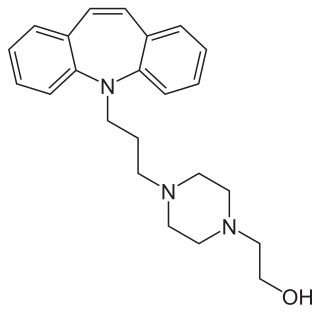Colloquially known as "downers", depressants or central depressants are drugs that lower neurotransmission levels, or depress or reduce arousal or stimulation in various areas of the brain. Depressants do not change the mood or mental state of others. Stimulants, or "uppers", increase mental or physical function, hence the opposite drug class from depressants are stimulants, not antidepressants.

An imidazopyridine is a nitrogen containing heterocycle that is also a class of drugs that contain this same chemical substructure. In general, they are GABAA receptor agonists, however recently proton pump inhibitors, aromatase inhibitors, NSAIDs and other classes of drugs in this class have been developed as well. Despite usually being similar to them in effect, they are not chemically related to benzodiazepines. As such, GABAA-agonizing imidazopyridines, pyrazolopyrimidines, and cyclopyrrones are sometimes grouped together and referred to as "nonbenzodiazepines." Imidazopyridines include:

Nalbuphine, sold under the brand names Nubain among others, is an opioid analgesic which is used in the treatment of pain. It is given by injection into a vein, muscle, or fat.

Opipramol, sold under the brand name Insidon among others, is an anxiolytic and tricyclic antidepressant that is used throughout Europe. Despite chemically being a tricyclic dibenzazepine (iminostilbene) derivative similar to imipramine, opipramol is not a monoamine reuptake inhibitor like most other tricyclic antidepressants, and instead, uniquely among antidepressants, acts primarily as a SIGMAR1 agonist. It was developed by Schindler and Blattner in 1961.

BIMU-8 is a drug which acts as a 5-HT4 receptor selective agonist. BIMU-8 was one of the first compounds of this class. The main action of BIMU-8 is to increase the rate of respiration by activating an area of the brain stem known as the pre-Botzinger complex.

Fenobam is an imidazole derivative developed by McNeil Laboratories in the late 1970s as a novel anxiolytic drug with an at-the-time-unidentified molecular target in the brain. Subsequently, it was determined that fenobam acts as a potent and selective negative allosteric modulator of the metabotropic glutamate receptor subtype mGluR5, and it has been used as a lead compound for the development of a range of newer mGluR5 antagonists.

Mecloqualone is a quinazolinone-class GABAergic and is an analogue of methaqualone that was first made in 1960 and marketed mainly in France and some other European countries. It has sedative, hypnotic, and anxiolytic properties caused by its agonist activity at the β subtype of the GABAa receptor, and was used for the treatment of insomnia. Mecloqualone is faster-acting but shorter-lasting than methaqualone and so was used only as a sleeping pill, in contrast to methaqualone, which was used as a general-purpose anxiolytic as well. Mecloqualone was never as widely used as methaqualone and is no longer prescribed because of concerns about its potential for abuse and overdose. In the United States it is a Schedule I non-narcotic (depressant) controlled substance with an ACSCN of 2572 and 30 grams annual aggregate manufacturing quota.

Cloroqualone is a quinazolinone-class GABAergic and is an analogue of methaqualone developed in the 1980s and marketed mainly in France and some other European countries. It has sedative and antitussive properties resulting from its agonist activity at the β subtype of the GABAa receptor and sigma-1 receptor, and was sold either alone or in combination with other ingredients as a cough medicine. Cloroqualone has weaker sedative properties than methaqualone and was sold for its useful cough-suppressing effects, but was withdrawn from the French market in 1994 because of concerns about its potential for abuse and overdose.

Etaqualone is a quinazolinone-class GABAergic and is an analogue of methaqualone that was developed in the 1960s and marketed mainly in France and some other European countries. It has sedative, hypnotic, muscle relaxant and central nervous system depressant properties resulting from its agonist activity at the β-subtype of the GABAA receptor, and was used for the treatment of insomnia.

Mebroqualone (MBQ) is a quinazolinone-class GABAergic and is an analogue of mecloqualone that has similar sedative and hypnotic properties to its parent compound, resulting from its agonist activity at the β subtype of the GABAa receptor. It was originally synthesized in the 1960s Mebroqualone differs from mecloqualone by having a bromine atom instead of a chlorine on the 3-phenyl ring. It was made illegal in Germany in 1998 but little other information is available. It would appear that this compound was sold on the black market in Germany as a designer drug analogue of mecloqualone.

Antihistamines are drugs which treat allergic rhinitis, common cold, influenza, and other allergies. Typically, people take antihistamines as an inexpensive, generic drug that can be bought without a prescription and provides relief from nasal congestion, sneezing, or hives caused by pollen, dust mites, or animal allergy with few side effects. Antihistamines are usually for short-term treatment. Chronic allergies increase the risk of health problems which antihistamines might not treat, including asthma, sinusitis, and lower respiratory tract infection. Consultation of a medical professional is recommended for those who intend to take antihistamines for longer-term use.

Afloqualone (Arofuto) is a quinazolinone family GABAergic drug and is an analogue of methaqualone developed in the 1970s by a team at Tanabe Seiyaku. It has sedative and muscle-relaxant effects resulting from its agonist activity at the β subtype of the GABAa receptor and has had some clinical use, although it causes photosensitization as a side-effect that can cause skin problems such as dermatitis.

L-838,417 is an anxiolytic drug used in scientific research. It has similar effects to benzodiazepine drugs, but is structurally distinct and so is classed as a nonbenzodiazepine anxiolytic. The compound was developed by Merck, Sharp and Dohme.

Y-23684 is an anxiolytic drug with a novel chemical structure, which is used in scientific research. It has similar effects to benzodiazepine drugs, but is structurally distinct and so is classed as a nonbenzodiazepine anxiolytic.

Tebanicline is a potent synthetic nicotinic (non-opioid) analgesic drug developed by Abbott. It was developed as a less toxic analog of the potent poison dart frog-derived compound epibatidine, which is about 200 times stronger than morphine as an analgesic, but produces extremely dangerous toxic side effects. Like epibatidine, tebanicline showed potent analgesic activity against neuropathic pain in both animal and human trials, but with far less toxicity than its parent compound. It acts as a partial agonist at neuronal nicotinic acetylcholine receptors, binding to both the α3β4 and the α4β2 subtypes.

ELB-139 (LS-191,811) is an anxiolytic drug with a novel chemical structure, which is used in scientific research. It has similar effects to benzodiazepine drugs, but is structurally distinct and so is classed as a nonbenzodiazepine anxiolytic.

Arylcyclohexylamines, also known as arylcyclohexamines or arylcyclohexanamines, are a chemical class of pharmaceutical, designer, and experimental drugs.

In pharmacology, GABAA receptor positive allosteric modulators, also known as GABAkines or GABAA receptor potentiators, are positive allosteric modulator (PAM) molecules that increase the activity of the GABAA receptor protein in the vertebrate central nervous system.

A GABA analogue is a compound which is an analogue or derivative of the neurotransmitter gamma-Aminobutyric acid (GABA).



















